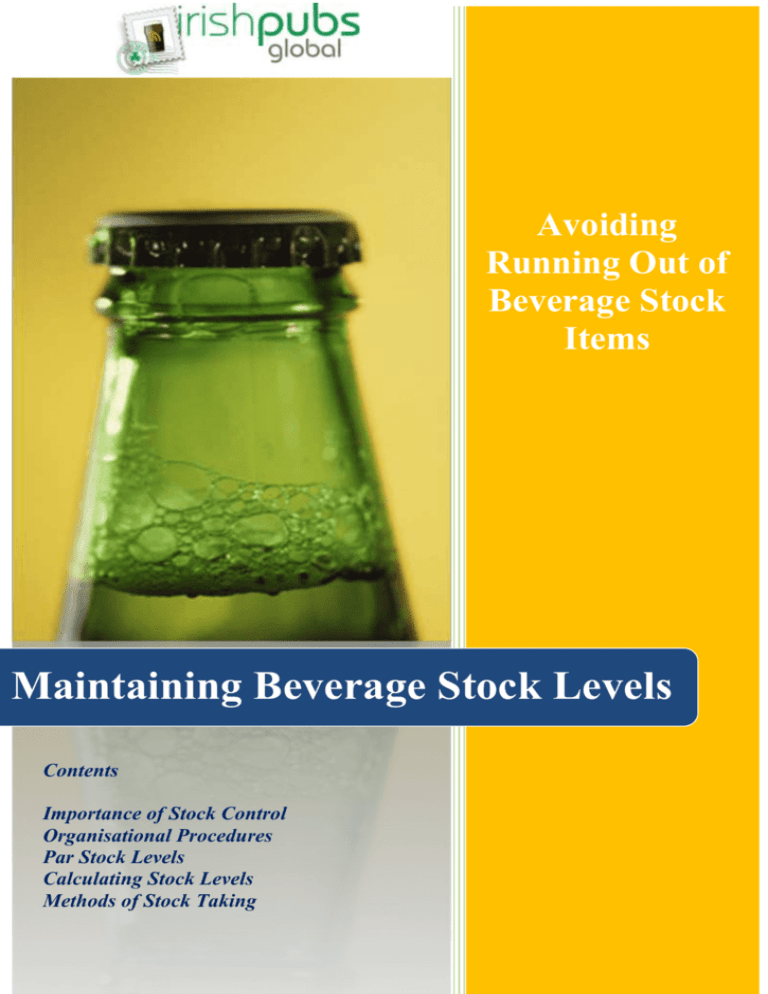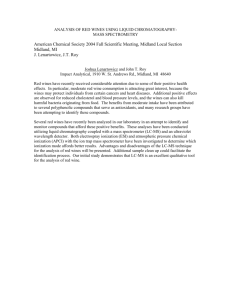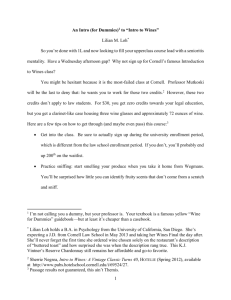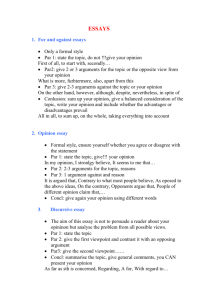Contents Trainee Information 3 Certificate of Completion 4
advertisement

Avoiding Running Out of Beverage Stock Items Maintaining Beverage Stock Levels Contents Importance of Stock Control Organisational Procedures Par Stock Levels Calculating Stock Levels Methods of Stock Taking Contents Trainee Information 3 Certificate of Completion 4 Importance of Stock Control 5 Organisational Procedures 6 Par Stock Levels 7 Calculating Stock Levels 8 Methods of Stocktaking 8 Timeframe for Stocktaking and inspections 9 Improving Sales of Slow Moving Stock 9 Stock Catering for Functions 10 Dealing with Unexpected Problems 11 Self Assessment Test 13 2 Training Manual Beverage Stock Control This Manual is designed to provide you, the employee/manager, with the full knowledge of all procedures associated with beverage stock control in your establishment for the purpose of maintaining supply of advertised items. You will be aware of all organisational procedures for recording and maintaining par stock levels in the stores and bars as well as the procedures and methods for stocktaking. Trainee Information Name: ____________________________________________ Manager: ____________________________________________ Training Commenced: ______ / ______ / ______ (DD/MM/YYYY) Training Completed: ______ / ______ / ______ (DD/MM/YYYY) Assessment Completed: ______ / ______ / ______ (DD/MM/YYYY) 3 Certificate of Completion I _______________________ (Manager/Supervisor) hereby certify that _______________________ (Employee Name) has successfully completed their training in “Maintaining Beverage Stock Levels” and is fully qualified under the requirements of the establishment in which they are employed herewith. ____________________________________ (Signature of Manager/Supervisor) ____________________________________ Date ____________________________________ (Signature of Trainee) ____________________________________ Date Congratulations! 4 Importance of Stock Control It is important that a constant stock of drinks is maintained. Guests expect that their requirements will be met in our bars. This means that we must ensure that we have the stock required to meet these needs in order to ensure their satisfaction. Bartenders must be able to work quickly and efficiently, which means that everything that might be required for service must be immediately to hand. For this reason, it is important that ordering be done accurately and in advance of the commencement of service. Overstocking of stores and bars ties profits up in stocks, rather than having it in the bank where it should be. Par stocks ensure that stocks are never higher than they should be, but that they are also adequate for service. Failure to stock the bar adequately results in guest dissatisfaction, which can mean that guests are lost to competitors. 5 Organisational Procedures Inspect Receiving Procedures Monitor the receiving procedures by personal observation to ensure that the receiving procedures are fully complied with. If you observe problems in the receiving procedures, investigate the causes of the problems by consulting with the staff involved. Encourage them to recommend improvements Make recommendations for improvements to these procedures to your Manager. Damage, Deterioration and Wine Stock Losses Any damaged bottles or leaking bottles that suggest deterioration of the wine should be set aside and recorded in the Ullage Book so that they can be included in the next stock take. Check that other bottles in the same are not also damaged. If they are, action must be taken with the supplier and the stock must be replaced. If stock losses become apparent during the last stock take, use this opportunity to check if the storage conditions may have contributed. Stock Records The Ullage Book must be kept up-to-date, and must be made available to the stocktaker at every stock take The Order Book must be correctly completed, and copies of the relevant pages attached to Delivery notes when stock is delivered. These must then be made available to the stocktaker at the stipulated times. 6 Par Stock Levels Par stock levels are the minimum and maximum stock-on-hand levels. The Par-Stock system is a financially effective tool to maintain sufficient stock levels. Factors that impact on stock levels when using the par-stock system include the following: Rate of demand (consumption levels)- the rate at which stock is consumed. Storage or shelf life of the various products. The shelf life of a product determines the quantity of product to be ordered. Use-by-dates indicate when to expect expiry. Frequency of product usage, indicates frequency of product replenishment. If it is a product with a high turnover or a high deterioration rate it will need to be ordered on a more regular basis. Storage conditions Maintenance Standards within these areas include temperature, humidity, ventilation control and pest control. These affect life-span and quality of stock. Seasonal demands e.g. ice-cream is more popular in summer Minimum delivery quantities These are stipulated to ensure that a substantial order is placed and the company is charged a delivery fee if orders are below the required minimum quantity. This can become fairly expensive if orders are placed daily in no organised manner. Bar Stocks Information to consider in anticipating shortfalls in bar stocks: The par stock is based on average expected business. By ordering stock to bring supplies back up to par, you are anticipating and preventing shortfalls. In addition, if restaurant reservations are far more than usual, this is also an indicator that additional stock should be ordered. Only move wines from the cellar to the bar as follows: Wines should only be moved from the cellar to the bar as they are required in terms of the maintenance of par stock levels. Old red wines should be moved early in the day to allow them to settle. Wines should only be moved to the bar if they can go directly into the correct storage conditions - e.g. only move white wines when there is space in the fridge. Calculating Stock Levels 7 Procedures for calculating stock levels are as follows: Establish consumption levels over a set period of time (e.g. 5 days) by monitoring daily usage by conducting stock takes Determine lead times for deliveries e.g. 10 days Example Guinness Pints consumed at an average of 20 per day x 5 days = 100 per week. Therefore minimum stock required for the month to meet demands would equal 400 Pints. Considering lead time factor of 10 days, increase minimum stock order by 200 Pints (average consumption of 20/day x lead time of 10 days). This will give a total stock level of 600 Pints for the month, which is sufficient to meet the demand and accommodate a small buffer stock in the event of an unexpected situation where the delivery time is not met. Methods of Stock Taking Liase with the Bartender: To ensure that the wines listed on the wine list are in stock. In the case of Banqueting, this should be discussed a week before the function. Where wines are out of stock, make a note so that you can inform service staff at the briefing immediately before service. Where stocks of wines are low (e.g. there are only 1 or 2 bottles of a particular wine left) make a note of this so that service staff can be informed. Find out when stocks of these wines are expected. If the Bartender has been waiting for stocks, contact the Store man or the Purchasing Department to find out when deliveries are expected. Check the conditions under which wine is stored. Ensure that the storage area is hygienically clean and tidy and that stock is stored according to the required standards. Before stock taking refer to the following stock records and documents to update on stock movements: Stock & Order book Purchase analysis sheet Claims procedure Transfers procedure Conduct an accurate stock take by doing a stock take every week Weighing / counting and recording accurately. 8 Time Frame for Stock Taking and Inspections Stock take should occur at regular intervals: Daily (for fast moving items) Weekly Monthly The main bar should be inspected at least once a week, preferably at random as should the cellar and storage areas. An inspection should take approximately 20 - 30 minutes. Improving Sales of Slow Moving Stock It is suggested that the supervisor establish why a particular level of stock is not moving out of the storage areas and thereafter plan a method of improving the sales. Slow moving stock can be identified during stock taking procedures when a surplus is recognised. When there is a lack of request for more stock, it can be determined that this is slow moving stock. Slow moving stock can occur for a number of reasons, e.g. too expensive etc. 9 Stock Catering for Functions Collection of Cash When stock catering for functions, it is important that the supervisor establish the total number of guests that will be attending the function, the preferred beverages required and then only order stock so that, wastage is minimised and appropriate stock levels to meet function demands are maintained. This needs to be achieved according to the following standards: Accurate counting and record keeping Stock adjustments recorded as soon as they take place Accurate Record Keeping It is imperative that an accurate record of stock is maintained at all times for effective control purposes. Check that Ullage Records are kept up to date and made available to the stocktaker when stocktaking is done Ensure that all duplicate orders, etc. are also made available to the stocktaker Keep records of maintenance reports so that effective follow-up can take place. Dealing with Unexpected Problems Equipment Failure 10 Report equipment problems to the Maintenance Department so that repairs can be carried out. Main Bar: Report equipment problems to your supervisor so that repairs can be carried out. Refrigerated cabinets operate in much the same way as an air-conditioned cupboard. This means that they cool and de-humidify the air in the cabinet. Faults are clearly apparent if the cabinet is not holding a temperature of around 7°C, or if water is collecting in the bottom - indicating that the cabinet is not draining properly. Power Failures Power failures may occur from time to time, resulting in fluctuations in cellar temperature. This is bad for the wine, so it is important to ensure that the wines are protected from this as far as possible. Ensure that the cellar is not left open or that it is opened and closed too often during power failures as this raises the cellar temperature. If you are in a hot climate, the cellar should be on the back-up generator circuit so that the temperature can be maintained in the event of power failures. Bar: Ensure that the fridges are not left open or that they are not opened and closed too often during power failures as this raises the temperature. If possible, put ice and water into large bins or baths and place stock that must be chilled into these. Product Failure, Damage, Deterioration and Stock Losses Any damaged bottles or leaking bottles that suggest deterioration of the product or product loss should be set aside and recorded in the Ullage Book so that they can be included in the next stock take. Check that other bottles of the same product are not also damaged. If they are, action must be taken with the supplier and the stock must be replaced. If stock losses became apparent during the last stocktake, use this opportunity to check if the storage conditions may have contributed Human Errors 11 In the course of your inspections, you may come across mistakes made by the Stores staff, including failure to turn equipment on as required. As soon as you notice this, bring it to the attention of the Storeman/Supervisor. If it is a persistent problem that you have brought to the attention of the Storeman/Supervisor several times, you may consider it appropriate to take disciplinary action. Mishandled Products If you observe products being mishandled, check if this has resulted in damage to the product. If damage has resulted, try to return the product to the supplier. If they will not accept it, you will have to write it off according to the appropriate accounting procedures. It is important to investigate the matter and possibly take disciplinary action in such an instance. Industrial Action If industrial action is threatening or is underway, ensure that the storage areas are properly secured, and supervised by a responsible person. If deliveries are affected by industrial action at suppliers, inform the Bartenders of the stock that will be affected. If it is basic stock (such as beer or cold drinks) try to obtain stock from another source SELF ASSESSMENT TEST 12 The following test is designed to assist you in remembering all the things you have learnt in this Training Manual. 1. What are the factors that influence stock levels? ___________________________________________________________________ ___________________________________________________________________ ___________________________________________________________________ 2. What are the actions that need to be taken when following organisational procedure for recording and maintaining par stock levels? ___________________________________________________________________ ___________________________________________________________________ ___________________________________________________________________ 3. What documentation and records should be referred to before stock taking? ___________________________________________________________________ ___________________________________________________________________ ___________________________________________________________________ 4. What is the appropriate action for dealing with unexpected problems like the following: 1. Human Error 2. Industrial Action 3. Product Failure ___________________________________________________________________ ___________________________________________________________________ ___________________________________________________________________ 13








